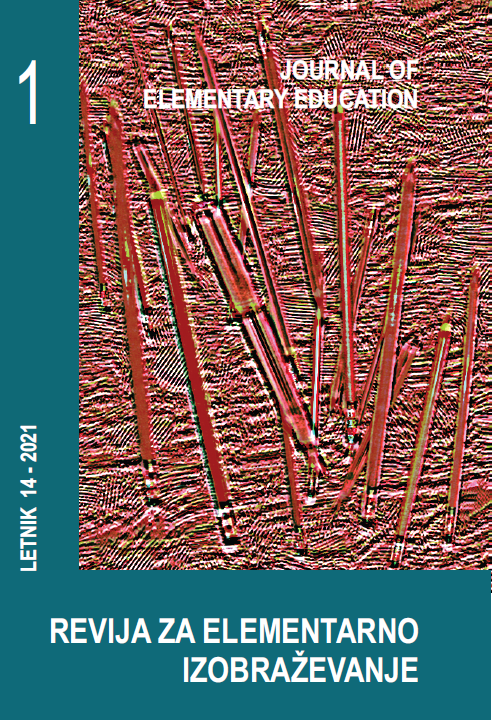Pozabljeno naravoslovje? Izkušnje in znanje iz naravoslovja pri šolarjih – Pilotna študija v osrednji Švici
Povzetek
Pilotna študija proučuje, koliko današnji osnovnošolci (6. razred, n = 142, 55.6 % dečki) poznajo običajne lokalne rastlinske in živalske vrste ter ali se to znanje razlikuje glede na izbrane kontekstualne spremenljivke. Opisna analiza je pokazala, da je naravoslovje zelo pomembno in da je večina otrok že pridobila nekaj osnovnega naravoslovnega znanja. V povprečju so pravilno prepoznali 51.2 % živali in 36.2 % prikazanih rastlin, a v njihovem znanju so bile očitne vrzeli. Predstavljeni rezultati so pokazali jasno povezavo med poznavanjem domačih živalskih in rastlinskih vrst, in sicer glede na narodnost otroka, glede na to, če imajo doma vrt in če starši spodbujajo njihovo zanimanje za naravo.
Prenosi
Literatura
Bebbington, A. (2005). The ability of A-level students to name plants. Journal of Biological Education, 39(2), 63–67.
Bögeholz, S. (1999). Qualitäten primärer Naturerfahrung und ihr Zusammenhang mit Umweltwissen und Umwelthandeln. Opladen: Leske und Budrich.
Brämer, R., Koll, H. & Schild, H.-J. (2016). 7. Jugendreport Natur 2016. Erste Ergebnisse. Natur Nebensache? Retrieved from https://www.natursoziologie.de (Accessed: 1st March 2019).
Deutschschweizer Erziehungsdirektoren-Konferenz (D-EDK) (2016). Lehrplan21. Natur, Mensch, Gesellschaft. Luzern: D-EDK Geschäftsstelle.
Gebhard, U. (2001). Kind und Natur. Die Bedeutung der Natur für die psychische Entwicklung. Wiesbaden: Westdeutscher Verlag.
Gerl, T., Almer, J., Zahner, V. & Neuhaus, B. J. (2018). Der BISA-Test: Ermittlung der Formenkenntnis von Schülern am Beispiel einheimischer Vogelarten. Zeitschrift für Didaktik der Naturwissenschaften (ZfDN), 24, 235–249.
Hunt, A., Stewart, D., Burt, J., & Dillon, J. (2016). Monitor of Engagement with the Natural Environment: a pilot to develop an indicator of visits to the natural environment by children - Results from years 1 and 2 (March 2013 to February 2015). Natural England Commissioned Reports, Number 208.
Huxham, M., Welsh, A., Berry, A., & Templeton, S. (2006). Factors influencing primary school children’s knowledge of wildlife. Journal of Biological Education, 41(1), 9–12.
Kahn, P. H. Jr., & Weiss, T. (2017). The importance of children interacting with big nature. Children, Youth and Environments, 27(2), 7–24.
Kögel, A., Regel, M., Gehlhaar, K.-H. & Klepel, G. (2000). Biologieinteressen der Schüler. Erste Ergebnisse einer Interviewstudie. In H. Bayrhuber & U. Unterbruner (Eds.),
Lehren und Lernen im Biologieunterricht (pp. 32-45). Innsbruck: Studienverlag.
Kühnis, J. (2018). Biodiversität – ein Schlüsselthema im Kontext einer Bildung für nachhaltige Entwicklung. Thematische Relevanz und curriculare Verortung in der Schweizer Schulbildung. In: P.-M. Rabensteiner, O. Holz & M. Michielsen (eds.),
Teacher Education, Sustainability and Development. Challenges, Issues, Solutions for Teaching in the 21st Century. (pp. 233–242). Erziehungswissenschaft. Vienna: LIT Verlag
Leske, S. & Bögeholz, S. (2008). Biologische Vielfalt lokal und global erhalten – Zur Bedeutung von Naturerfahrung, Interesse an der Natur, Bewusstsein über deren Gefährdung und Verantwortung. Zeitschrift für Didaktik der Naturwissenschaften (ZfDN), 14, 167–184.
Lindemann-Matthies, P. (2002). Wahrnehmung biologischer Vielfalt im Siedlungsraum durch Schweizer Kinder. In R. Klee, & H. Bayrhuber (Eds.), Lehr- und Lernforschung in der Biologiedidaktik (p. 117–130). Innsbruck, Austria: Studienverlag.
Lindemann-Matthies, P. (2005). “Loveable” mammals and “lifeless” plants: How children’s interest in common local organisms can be enhanced through observation of nature. International Journal of Science Education, 27, 655–677.
Lindemann-Matthies, P., Constantinou, C., Lehnert, H.-J., Nagel, U., Raper, G., & Kadji-Beltran, C. (2011). Confidence and perceived competence of preservice teachers to implement biodiversity education in primary schools - Four comparative studies from Europe. International Journal of Science Education, 33, 2247–2273. Lindemann-Matthies, P., Remmele, M. & Yli-Panula, E. (2017). Professional competence of student teachers to implement species identification in schools – a case study from Germany. CEPS Journal, 7(1), 29–47.
Louv, R. (2005). Last Child in the Woods: Saving our children from nature-deficit disorder. Chapel Hill, NC: Algonquin.
Meske, M. (2011). «Natur ist für mich die Welt». Lebensweltlich geprägte Naturbilder von Kindern. Wiesbaden: Springer VS Verlag.
Pohl, D. T. (2006). Naturerfahrungen und Naturzugänge von Kindern. Dissertation, Pädagogische Hochschule Ludwigsburg.
Raith, A. & Lude, A. (Eds.) (2014). Startkapital Natur. Wie Naturerfahrung die kindliche Entwicklung fördert. Munich: Oekom.
Randler, C. (2006). War früher alles besser? Eine Untersuchung zu Wirbeltierartenkenntnissen bei Schülerinnen und Schülern. Natur und Landschaft, 81(11), 547–549.
Remmele, M. & Lindemann-Matthies, P. (2018). Like father, like son? On the relationship between parents’ and children’s familiarity with species and sources of knowledge about plants and animals, EURASIA Journal of Mathematics, Science and Technology Education, 14(10), 1–10.
Rieckmann, M. (2018). Key themes in Education for Sustainable Development. In A. Leicht, J. Heiss, & W.J. Byun, (Eds.), Issues and Trends in Education for Sustainable Development. (pp. 61-84). Education on the move. Paris. United Nations Educational, Scientific and Cultural Organization. Schutzgemeinschaft Deutscher Wald (SDW), Landesverband Bayern et al. (Eds.) (2009). Studie über das Waldwissen von bayerischen Schülern der 3. Jahrgangsstufe. Munich: SDW.
Skar, M., Wold, L. C., Gundersen, V. & O’Brien, L. (2016). Why do children not play in nearby nature? Results from a Norwegian survey, Journal of Adventure Education and Outdoor Learning, DOI:10.1080/14729679.2016.1140587.
Späker, T. (2016). Zur Bedeutung des Erfahrungsraums Natur für eine psychomotorisch-motologische Entwicklungs- und Gesundheitsförderung. Dissertation am Fachbereich Erziehungswissenschaften der Universität Marburg.
Tremblay, M.S., Gray, C., Babcock, S., Barnes, J., Bradstreet C.C., Carr, D., Chabot, G., Choquette, L., Chorney, D., Collyer, C., Herrington, S., Janson, K., Janssen, I., Larouche, R., Pickett, W., Marlene Power, M., Sandseter, E. B. H., Simon, B. & Brussoni, M. (2015). Position Statement on Active Outdoor Play. International Journal of Environmental Research and Public Health, 12, 6475–6505.
UNESCO (2017). Education for Sustainable Development Goals. Learning objectives. Paris: UNESCO. Retrieved from: http://unesdoc.unesco.org/images/0024/0024–74/247444e.pdf (Accessed: 1st March 2019).
Waller, T., Ärlemalm-Hagsér, E., Sandseter, E. B. H., Lee-Hammond, L., Lekies, K., & Wyver, S. (2017). Introduction. In T. Waller, E. Ärlemalm-Hagsér, E. B. H.
Sandseter, L. Lee-Hammond, K. Lekies, & S. Wyver (Eds.), SAGE Handbook of Outdoor Play and Learning (pp. 1–21). London: SAGE.
WWF Schweiz (2015). Schulen ab in die Natur. Lehrerumfrage Mai 2015. Zürich: WWF Schweiz.
WWF (2018). Living Planet Report 2018: Aiming higher. Gland: WWF Switzerland.
Copyright (c) 2021 University of Maribor

To delo je licencirano pod Creative Commons Priznanje avtorstva 4.0 mednarodno licenco.
